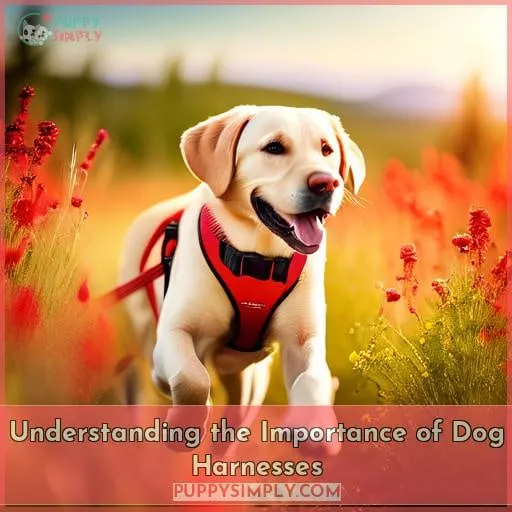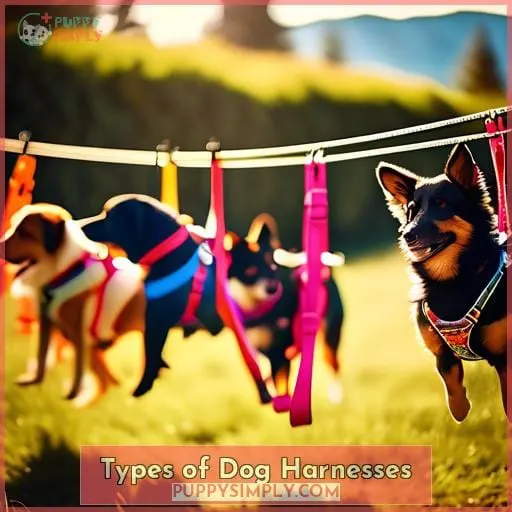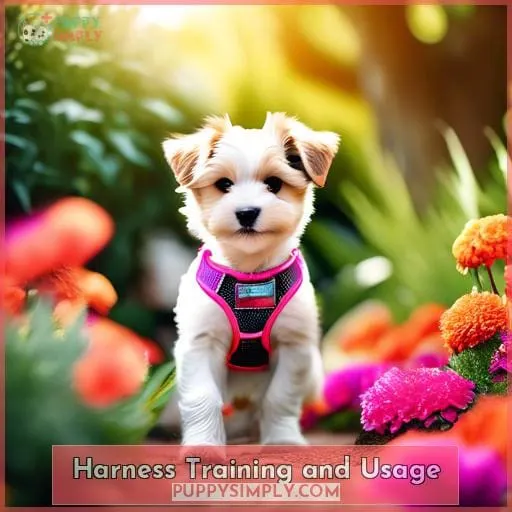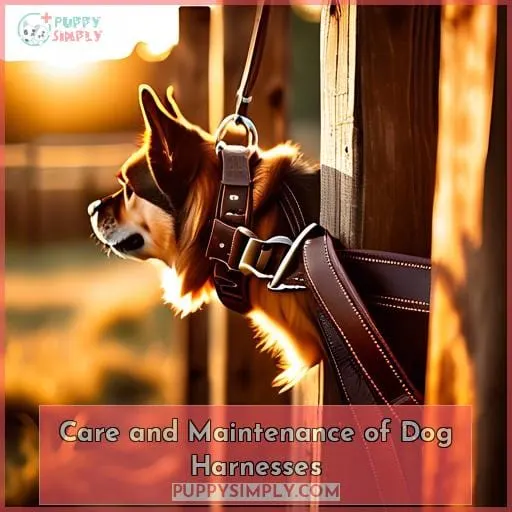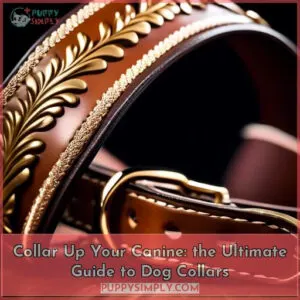This site is supported by our readers. We may earn a commission, at no cost to you, if you purchase through links.
 Ensuring your dog’s safety and comfort starts with the right pet harness.
Ensuring your dog’s safety and comfort starts with the right pet harness.
Whether you’re strolling through the park or embarking on an adventure, a well-fitted harness can prevent injuries and enhance control.
Dive into the world of dog harnesses with us, where we’ll guide you through:
- Choosing the perfect style for your pup’s activities
- Training them for a comfortable fit
- Maintaining their new gear
Let’s secure your furry friend’s well-being together.
Table Of Contents
Key Takeaways
- Harnesses evenly distribute pressure across a dog’s body to reduce strain on the trachea and neck.
- Different types of harnesses serve different purposes – head halters control head movement, step-in harnesses are easy to put on, and front-clip harnesses help reduce pulling.
- Properly fitted harnesses with durable materials and comfortable padding provide security, comfort, and safety for dogs.
- Harness training requires patience, consistency, positive reinforcement, and adjusting to each dog’s needs over time.
Understanding the Importance of Dog Harnesses
As a dog owner, you must consider your companion’s safety and comfort.
Both harnesses and collars serve purposes in walking, identification, and control.
Harnesses provide extra security and reduce pressure on the neck.
Understanding the comparative benefits helps you make the best choice for your dog’s needs.
Safety and Comfort Benefits of Harnesses
You’ll frequently find that harnesses provide greater safety and comfort for dogs because they evenly distribute pressure across the body rather than concentrating it on the neck area like collars do.
When properly fitted, harnesses reduce strain on the trachea while allowing control via adjustable straps and attachment points effective for leash training.
Features like padded chest pieces and reflective stitching boost comfort and safety during walks.
Consider material preferences and behavioral impacts when selecting the right harness.
Harnesses Vs. Collars: a Comparative Analysis
One will find harnesses better distribute force across the dog’s body, while collars concentrate force on the neck during walks.
Harnesses provide improved comfort and reduce strain.
However, training remains essential to address behavioral issues like pulling, so consider a front or back-clip harness paired with positive reinforcement.
Ultimately, select gear ensuring your dog’s safety and training efficiency.
Types of Dog Harnesses
Here, we’ll overview different harness styles and discuss harnesses designed for specific needs and activities.
When choosing a harness for your dog, consider their breed, body type, and intended use.
Certain harnesses work better for pulling, running, hiking, or providing extra control.
Overview of Different Harness Styles
Depending on your dog’s size, shape, and needs, you’ll find a wide array of harness styles from which to choose:
- Head halters
- Step-in harnesses
- Back-clip harnesses
- Front-clip harnesses
- Vests
With styles like back-clip favored for casual walks and front-clip better for pulling, consider your dog’s body, personality, and activities when selecting for the best comfort, control, and safety.
Adjustment points, leash attachments, padding, and breathable fabrics all provide the custom, cozy fit needed for your pup’s walks and adventures.
Harnesses for Specific Needs and Activities
When choosing a dog harness, you’ll want to consider your pup’s unique needs and favorite activities, as different harness types suit different purposes:
- The Easy Walk harness has a front clip to deter pulling.
- The Kurgo Tru-Fit Crash-Tested harness is ideal for car trips.
- The Ruffwear Front Range hiking harness comes with reinforced webbing for outdoor adventures.
Hikes in the mountains
Car rides to the dog park
Evening neighborhood strolls
Selecting the Right Harness for Your Dog
When choosing a harness for your pup:
- First, take precise measurements around their chest and neck to ensure a proper fit.
- Also consider factors like your dog’s size, activity level, and comfort preferences when selecting design, material, padding, and hardware.
Properly fitting and designed harnesses provide control and security without irritating your dog’s skin or limiting their movement.
Measuring Your Dog for a Proper Fit
Before selecting a harness, you’ll need to properly measure your dog to ensure the best fit.
Use a soft measuring tape to carefully measure around their chest behind their front legs.
For strap harnesses, ensure it’s snug but not constricting – you should be able to slide two fingers between the strap and their body.
Make sizing adjustments and re-verify a comfortable fit.
Proper sizing promotes safety, while regular comfort assessments ensure your dog stays happy in their adjustable dog harness.
Material and Design Considerations
You’ll then want to consider the material and design of the harness for your dog’s comfort and needs.
Look for durable materials like nylon straps and metal hardware paired with comfortable padding and breathable design from neoprene.
Adjustable straps allow a custom fit while reflective elements boost visibility.
Prioritize a D-ring leash attachment point for control against pulling with options like padded chest panels for sensitive pups.
Harness Training and Usage
As you introduce your dog to a harness:
- Go slow and keep sessions positive and short.
- Address any harness issues right away, like reluctance to step into it or pulling while wearing it.
With time and tasty treats, your dog can master walking politely in their new harness.
Introducing Your Dog to a Harness
One of your best next steps is to slowly acclimate your dog to wearing a harness through positive reinforcement.
Introduce the harness gradually with treats, praise, and play.
Let your dog sniff, lick, and explore the harness at their own pace.
Patiently work through any objections with more treats and encouragement.
Persist with short sessions of having your dog wear the harness in the house or yard before going on walks.
Consistency builds acceptance through positive associations.
Soon your dog will see their harness and eagerly anticipate going for a walk with you.
Addressing Common Issues Like Pulling
Use positive reinforcement training to curb your dog’s impulse to pull while walking in a harness.
When your dog walks nicely beside you without pulling, praise and reward with treats.
Practice loose-leash walking during distraction-free indoor sessions, then generalize the skill to outdoor environments with more distractions.
Be consistent and reinforce calm walking to establish good leash manners over time.
Dual-clip harnesses with a front D-ring can also help by changing your dog’s leverage point.
Care and Maintenance of Dog Harnesses
You’ll want to regularly check your dog’s harness for proper fit and make any needed adjustments to ensure their comfort and safety.
It’s also important to periodically hand wash the harness with mild soap and water and allow it to fully air dry before storing to prevent mildew and maintain the quality.
Caring for your dog’s harness through routine checks, cleaning, and proper storage will help extend its lifespan.
Regular Checks and Adjustments
Before you put the harness on your dog, make sure the straps and buckles are in good working order so it fits comfortably and securely.
Check for signs of wear on straps, such as fraying or tearing.
Inspect metal parts like buckles and D-rings for damage or sharp edges.
Reassess sizing by having your dog stand up while wearing the harness to evaluate fit and comfort.
Cleaning and Storage Tips
You’ll want to regularly clean your dog’s harness to remove dirt, hair, and odors.
Check the care instructions, as some harnesses can be machine washed while others need to be spot cleaned.
It’s best to air dry harnesses after cleaning rather than putting them in the dryer.
When not in use, store the harness in a cool, dry place to prevent damage and warping.
| Cleaning Method | Frequency | Supplies Needed |
|---|---|---|
| Spot Cleaning | After Each Use | Pet-safe cleaner, soft brush |
| Machine Washing | Monthly | Laundry detergent |
| Deep Cleaning | As Needed | Baking soda, vinegar |
Frequently Asked Questions (FAQs)
How tight should a dog harness be?
The harness should be snug but not uncomfortably tight. You should be able to fit two fingers between the strap and your dog’s body.
It needs to allow full range of motion without slipping or chafing.
Finding the right fit takes some trial and error, so check for rubbing and looseness during walks.
Can I leave a harness on my dog all the time?
Like a cozy sweater on a chilly day, a harness should offer comfort, not confinement.
You shouldn’t leave a harness on your dog constantly; it can cause skin irritation, matting, and even injury.
What’s the best harness for a dog that pulls?
When choosing a harness for a dog that pulls, prioritize no-pull designs with attachments at both the back and chest.
These distribute pressure across the body, allowing control without pain.
Always combine equipment with positive reinforcement training.
Should I get a harness for my puppy?
Embracing a harness for your puppy is akin to wrapping them in a gentle hug, ensuring their tiny frame is supported and safeguarded during those exploratory leaps and bounds.
This choice, deeply rooted in a blend of medical insight and hands-on experience, not only curtails the risk of neck injuries but also fosters a nurturing bond between you and your furry companion.
It’s a beacon of safety in the bustling world, guiding your pup with love and understanding, while offering you the control needed to steer their youthful energy.
Is it okay for my dog to wear a harness and a collar at the same time?
I wouldn’t recommend having your dog wear a collar and harness simultaneously.
Doing so risks putting excessive pressure on your dog’s neck and trachea.
For walking and training purposes, a properly fitted harness is the safer option.
Reserve collars for ID tags only.
Conclusion
A dog harness is truly the gift that keeps on giving when it comes to your pup’s safety and comfort.
With a hyperbolic number of options available, take the time to find the perfect harness for your dog’s needs.
Measure carefully, train patiently, and care diligently, and your furry friend will stay secure on all of your adventures together.
Choose wisely, use properly, and maintain consistently, and your dog’s harness will become their home away from home.

